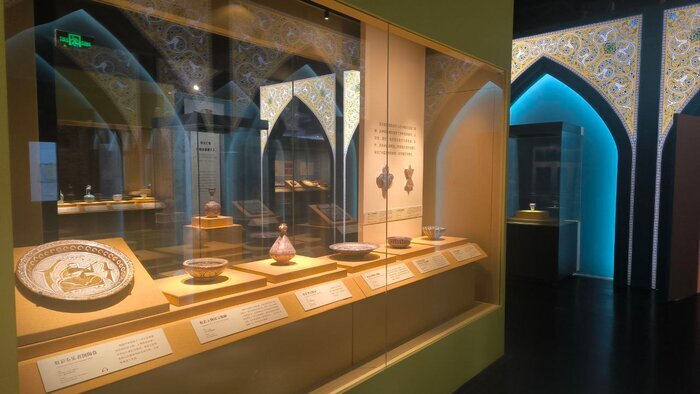Tehran – Guangzhou Museum in Guangzhou is currently hosting the “Land of Kindness” of Iranian cultural artefacts exhibition, offering visitors an unusual glimpse into the five thousand years of Persian art, culture and craftsmanship.
The Loan Exhibition, which first opened a few months ago at the Sichuan University Museum in Chengdu, encountered a wide range of public interest and enthusiastic media coverage in China.
Organized under the auspices of the Ministry of Cultural Heritage, Tourism and Handicrafts of Iran, the exhibition will be held in full compliance with the International Museum’s standards and legal framework. The event is a joint effort by the province’s Deputy Bureau of Cultural Heritage, Museum Directorate, Tehran Province Office, Tehran University and its Chinese counterparts.
Land of Kindness presents 151 selected cultural and historical artifacts that have been rented from several of Tehran’s prestigious museums, including the Mogadam Museum at Tehran University, the Reza Abbasi Museum, the Carpet Museum in Iran, and the Museum of Iran’s Glassware and Iran’s Pottery Museum.
From the 3rd millennium BC to the later Islamic period, items displayed include intricately crafted metalwork, ceramics, glassware, textiles and Persian carpets. These objects not only show the artistic evolution of Iran, but also tell us about important stages of cultural history, from the time of Mithra’s ritual to the emergence of Islam.

An important feature of the exhibition is its immersive design inspired by iconic elements of Iranian art and architecture. Visitors enter an area reminiscent of the Qur’an tilework at Golestan Palace in Tehran, but the main exhibition features stained glass and geometric patterns that inspire Shiraz’s Nasir al-Mark Mosque. This carefully curated atmosphere invites visitors to the spiritual and artistic hearts of Iranian heritage.
In a special joint section, the Guangdong Museum creatively juxtaposes Iranian and Chinese artifacts selected from its own collection. This artistic dialogue focuses on shared motifs such as glass-walled ceramics and images of flowers and birds, highlighting historical connections and mutual aesthetic sensibilities along the ancient Silk Road.

The exhibition, which will be held in Guangzhou from March 30th to June 16th, was welcoming with warmth from Chinese visitors. Many of them praise Iran’s rich cultural heritage and hope to learn more about it in the future.
In addition to presenting Iran’s artistic wealth, the land of kindness emphasizes the strengthening of cultural ties between Iran and China, promoting deeper understanding and gratitude through intercultural exchanges.
Last December, another loan exhibition from Iran, named “Ancient Persian Glory” was held at Xinjiang, following successful showcases in Beijing and Shanghai. Organized in collaboration with the Chinese government by the Ministry of Cultural Heritage, Tourism and Handicrafts of Iran, the exhibition exhibited over 280 artifacts spanning more than three,000 years of Persian history. The collection includes treasures from prominent archaeological sites across Iran, including the National Museum of Iran, the Persepolis Museum, and the Regional Museum of Rasht and Golgan.

An ancient land tainted by history, Iran dates back to 4,000 BC and boasts one of the world’s oldest and most continuing major civilizations. It is decorated with a wealth of cultural treasures, including bazaars, museums, mosques, bridges, baths, madrasas, gardens and diverse natural landscapes complemented by 28 UNESCO labels.
Looking through a wider lens, Iranian history unfolds in two different periods, pre-Islamic and Islam. The rise of Medes in 625 BC combined Iranian unity into states and empires. However, it was Persian Islamic conquest (633–656) that signaled a pivotal moment, ending the powerful Sassanid Empire (224–651) and reconstructing the country’s history course.
morning

